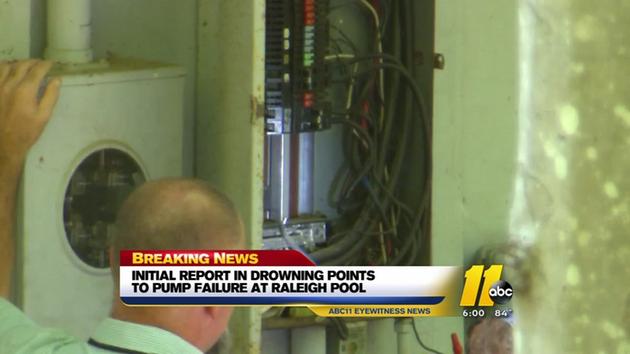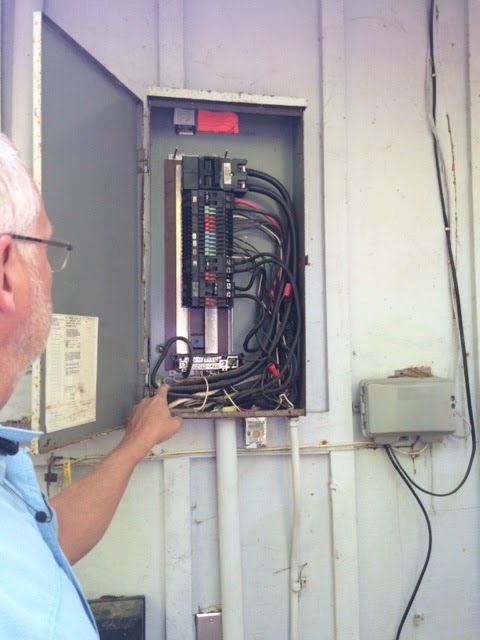


Initial report in drowning points to pump failure at Raleigh pool

Authorities examined the equipment at Heritage Point Pool (WTVD)
Monday, September 12, 2016 06:48PM
RALEIGH (WTVD) -- An initial report from the Wake County Inspections Administrations says a pool motor failure and a broken conductor led to the death of a teen lifeguard in Raleigh.
Rachel Rosoff, a senior at Enloe High School, was on duty and alone when a fellow employee showed up for work and found her floating face down in the water on September 3.
The report outlines everything investigators uncovered at Heritage Point Pool.
The pool was installed and permitted in 1979. Since then, no other construction permits have been filed.
The inspector cited a number of actions that, while unpermitted or not up to code, did not lead to the water being electrified. Among them, he found an unknown contractor repaired the electrical feeder to the pump in 2011 without the required permit. Also, a motor bonding wire had been cut and loosely wrapped around the equipment bonding wires, which does not comply with National Electrical Code.
In his conclusion, the inspector found the pool pump motor failed and when it faulted to ground, the grounded conductor was broken, causing the current to travel into the water and pool equipment.
"Since this conductor was open (broken) it could not conduct the necessary current to cause the overcurrent device (breaker) to open (trip)," Gregory Vance, Inspections Administrator, wrote. "The fault current then followed the only path available to it, the pool water, creating a voltage gradient across the pool and pool equipment."
The investigation was conducted at the request of the Wake County Sheriff's Office.
The NC Dept. of Labor, Occupational Safety and Health Division is also carrying out its own investigation to find whether safety or health standards were violated at Heritage Point Pool.
Read the full report here.

Authorities release the scene, but are still searching for clues as to why a pool became electrified.
========
DATE: September 9, 2016
FROM: Gregory A. Vance, Inspections Administrator
TO: Investigator W. O’Neal, Wake County Sheriff’s Office
RE: Investigation of Wiring at Heritage Point Community Pool
On September 6, 2016 Wake County’s Chief Electrical Inspector and Inspections
Administrator met with representatives of the Wake County Sheriff’s Office, the North Carolina Department of Labor, Occupational Safety and Health Division, Aquatic Management Group and Future Connections Electrical, Inc. at Heritage Point community pool to investigate the electrical wiring pursuant to the drowning death that occurred on September 3, 2016. The investigation and this
report were performed at the request of the Wake County Sheriff’s Office.
The pool was originally installed in 1979 and permitted under Wake County permit number A016724. There are no subsequent construction permits related to the pool or pool equipment on record. At the time of original installation of the pool, the 1978 National Electrical Code (NEC) was in effect. Unless otherwise noted, all code references are to that edition.
The investigation found that the pool pump was fed underground from a house panel (see image 1) located on the exterior of the community club house. The electrical feeder consisted of three conductors (two ungrounded and one grounded), typical of electrical practices of the period and compliant with NEC 250-61(a). Overcurrent at the panel was a 60 ampere breaker and conductors were #4 aluminum. The insulation type could not be identified. The electrical feeder to the pump had been repaired (see image 2) in 2011 per the representative of Aquatic Management Group.
Approximately 5 feet from the pool house, the old electrical feed had been relocated above ground, spliced to new type URD #2 aluminum conductors and the new conductors ran to the existing fused disconnect in the pool house. The County has no knowledge of who performed this work. Such work requires an electrical permit per N.C.G.S. 153A-357.
Representatives of Future Connections Electrical tested the grounded conductor of the electrical feeder to the pump for continuity between the house panel and the pool house disconnect and found that the conductor was open (broken/could not conduct electricity). They then tested to the junction at the repair and the conductor was still open indicating a break in the original ungrounded conductor installed in 1979.
Representatives of Future Connections Electrical located and excavated the break in the conductor (see image 3). The conductor was fully corroded and unable to conduct electricity. The electrical feeder terminated in a 60 ampere fusible disconnect (see image 4) inside the pool house. The disconnect was fused as 40 amperes on one leg and 60 amperes on the other leg. The disconnect appeared to be in proper working order and the overcurrent was set to within acceptable limits for code compliance.
From the disconnect, the motor branch circuit ran to a timeclock controlled motor starter and then to the motor. This branch circuit consisted of three conductors (two ungrounded and one grounding).
The conductors were #6 copper. The insulation appeared to be type THHN. The conductors appeared to be properly terminated in the disconnect, the motor starter and the motor.
Representatives of Future Connections Electrical tested the ungrounded conductors feeding the motor at the motor starter and found that phase A had faulted to ground. The motor bonding wire was terminated properly at the motor but had been cut and loosely wrapped around the equipment bonding wires (see image 5).
This alteration was located behind piping concealed from normal view. This is not compliant with NEC680.22 that required all metal parts of the pool structure, metal fittings, metal piping and fixed metal parts within five feet of the inside walls of the pool, and all electric equipment associated with the pool water circulating system, including pump motors to be bonded together.
However, it was discovered that an alternate electrical path provided a connection to the motor bonding wire and it was determined that the cut wire noted above did not contribute to the electrical charge in the pool. Furthermore, the function of the pool bonding system, in accordance with NEC 680.22, could not be verified at the time of the investigation.
It is my conclusion that, the pool pump motor failed and phase A faulted to ground. The underground feeder had an open ungrounded (neutral) conductor. The only load on this feeder is the 230 volt pump, therefore there was no indication that the ungrounded conductor had failed. Article 250-61(a) of the 1978 NEC states “A grounded circuit conductor shall be permitted to ground noncurrent-carrying metal parts of equipment . . . on the supply side of main disconnecting means of separate buildings. . .” This is intended to provide an effective ground-fault current path.
Article 100 of the 2014 NEC defines effective ground-fault current path as “. . . a low- impedance circuit facilitating the operation of the overcurrent device . . .” When the phase A faulted to ground, the intended path for fault current was the grounded(neutral) conductor. Since this conductor was open (broken) it could not conduct the necessary current to cause the overcurrent device (breaker) to open (trip). The fault current then followed the only path available to it, the pool water, creating a voltage gradient across the pool and pool equipment.
Gregory A. Vance
Inspections Administrator
Wake County PDI

